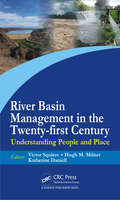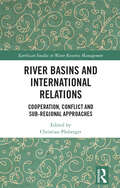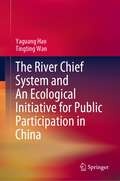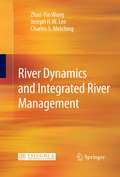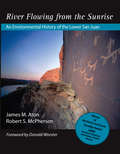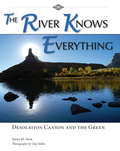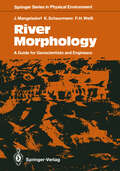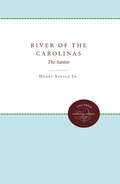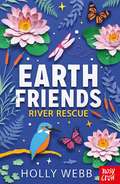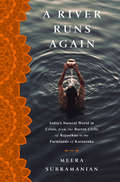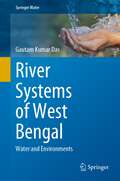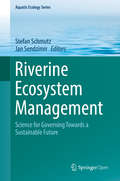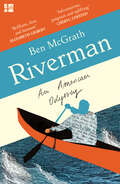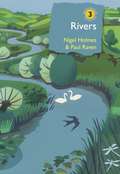- Table View
- List View
The River Basin in History and Law
by Ludwik A. TeclaffFresh water is one of man's most vital needs. The distribution of water within river basins has a direct bearing on the organization of water resources development to meet this ever-expanding need. River basins, despite their very great diversity in other respects, have one physical characteristic in common: each is a more or less self-contained unit within whose bounds all the surface and part or all of the ground waters form an interconnected, interdependent system. This inter dependence has such far-reaching implications - for pollution and flood control, apportionment of supply, relations between upstream and downstream riparians, to mention only a few examples - that the river basin has become almost universally accepted (within the past 20 or 30 years at least) as the unit of optimal water resources de velopment. Professor Teclaff's work (which was originally submitted to the New York University School of Law as a doctoral dissertation) is the first fully developed response to the important resolution passed by the International Law Association at its New York meeting in I958 recognizing the legal nature of the international river basin. His study quite properly, therefore, poses the question whether the adoption of the river basin unit is a temporary phenomenon, reflecting the current stage of technology and of administrative, economic, and legal thought on water resources development, or whether the de terminative influence of the river basin's physical unity which has always operated in the past will continue to operate in the future.
River Basin Management in the Twenty-First Century: Understanding People and Place
by Victor Roy Squires Hugh Martin Milner Katherine Anne DaniellWorldwide development of agriculture and industry creates burgeoning demands on natural resources. Management of the rivers and the surrounding landscape is one of the important tasks for today and for the foreseeable future. Lessons learned from centuries of management (and mismanagement) have been distilled into principles and practices which for
River Basins and International Relations: Cooperation, Conflict and Sub-Regional Approaches (Earthscan Studies in Water Resource Management)
by Christian PlobergerThis book argues that river basins represent a particular structural setting in international relations with the potential for generating a dynamic of cooperation among the involved countries. The volume applies the concept of regional cooperation to international river basins to highlight their relevance as a particular space in international relations, emphasizing both the inter-connectivity and transnationalism of international river basins. It addresses the challenges related to resource distribution between up- and down-stream countries, showcasing a variety of examples of cooperation and conflictual relations within various international river basins. Case studies are drawn from across the globe and include the Mekong, the Indus, the Euphrates-Tigris and the Danube international river basins. Each chapter outlines the different aspects which support or undermine cooperation in each case, taking into consideration key areas surrounding resource sharing, national development, environmental considerations and national security. This book will be of great interest to students and scholars with an interest in international river basins, regional cooperation, water resource competition, international relations and environmental politics.
River Basins and International Relations: Cooperation, Conflict and Sub-Regional Approaches (Earthscan Studies in Water Resource Management)
This book argues that river basins represent a particular structural setting in international relations with the potential for generating a dynamic of cooperation among the involved countries. The volume applies the concept of regional cooperation to international river basins to highlight their relevance as a particular space in international relations, emphasizing both the inter-connectivity and transnationalism of international river basins. It addresses the challenges related to resource distribution between up- and down-stream countries, showcasing a variety of examples of cooperation and conflictual relations within various international river basins. Case studies are drawn from across the globe and include the Mekong, the Indus, the Euphrates-Tigris and the Danube international river basins. Each chapter outlines the different aspects which support or undermine cooperation in each case, taking into consideration key areas surrounding resource sharing, national development, environmental considerations and national security. This book will be of great interest to students and scholars with an interest in international river basins, regional cooperation, water resource competition, international relations and environmental politics.
The River Chief System and An Ecological Initiative for Public Participation in China
by Yaguang Hao Tingting WanThis book provides an alternative agenda to deepening the understanding of the River Chief System as a distinctive responsibility approach to solve water pollution and associated governance dilemmas. Insightful analysis is performed through in-depth studies of the origins of China’s River Chief System, responsibility mechanisms, governmental and civil river chiefs, formal and informal water governing institutions, public participation, empowerment with accountability, and the environmental impact.
River Conservation and Management
by Philip J. Boon Paul J. RavenThis book is intended for those with an academic, scientific and practical interest in river conservation and management. It provides an overview of how changes in legislation, policies, institutional responsibilities, science, technology, practical techniques and public perception have influenced how rivers have been managed over the past 20 years and the challenges that lie ahead during the next 20 years. The book is based on the international conference River Conservation and Management:20 Years On held at York. Thirty-one chapters, with contributions from North and South America, Europe, Asia and Australasia provide a wide-ranging perspective on this complex but profoundly important subject. Following an introduction that chronicles the most important contextual changes, the book is organized into four broad topics: Catchment management, ecosystem integrity and the threats to river ecosystems – this covers progress on understanding and addressing the pressures affecting rivers, many of which will be amplified by climate change and increasing human demands for water; Methods and approaches – illustrating some recent techniques that have been developed to assess condition and conservation status across different types of river; Recovery and rehabilitation – providing an insight into the principles, practice, public involvement and institutional networks that support and make improvements to modified river reaches; Integrating nature conservation into wider river management –demonstrating the importance of integrated planning, involvement of local communities and the use of adaptive management in achieving multiple environmental and economic benefits along rivers used for different purposes. The final chapter discusses the challenges faced in dealing with an uncertain future. More than 1200 different references and numerous web-site citations provide the reader with an invaluable source of knowledge on the subject area.
River Conservation and Management
by Philip Boon Paul RavenThis book is intended for those with an academic, scientific and practical interest in river conservation and management. It provides an overview of how changes in legislation, policies, institutional responsibilities, science, technology, practical techniques and public perception have influenced how rivers have been managed over the past 20 years and the challenges that lie ahead during the next 20 years. The book is based on the international conference River Conservation and Management:20 Years On held at York. Thirty-one chapters, with contributions from North and South America, Europe, Asia and Australasia provide a wide-ranging perspective on this complex but profoundly important subject. Following an introduction that chronicles the most important contextual changes, the book is organized into four broad topics: Catchment management, ecosystem integrity and the threats to river ecosystems – this covers progress on understanding and addressing the pressures affecting rivers, many of which will be amplified by climate change and increasing human demands for water; Methods and approaches – illustrating some recent techniques that have been developed to assess condition and conservation status across different types of river; Recovery and rehabilitation – providing an insight into the principles, practice, public involvement and institutional networks that support and make improvements to modified river reaches; Integrating nature conservation into wider river management –demonstrating the importance of integrated planning, involvement of local communities and the use of adaptive management in achieving multiple environmental and economic benefits along rivers used for different purposes. The final chapter discusses the challenges faced in dealing with an uncertain future. More than 1200 different references and numerous web-site citations provide the reader with an invaluable source of knowledge on the subject area.
River Dynamics and Integrated River Management
by Zhao-Yin Wang Joseph H.W. Lee Charles S. Melching"River Dynamics and Integrated River Management” provides comprehensive information on rivers for integrated management, including natural processes, stresses resulting from human activities, and restoration of various parts of the river basin, including the watershed, mountain streams, alluvial rivers, estuaries, and natural and man-made lakes. Essential concepts, traditional and modern, such as river patterns, step-pool systems, vegetation-erosion charts, habitat diversity, and flushing times of bays, are clearly defined physically and explained with figures and pictures. Detailed mathematics and rigorous analyses are avoided so as to facilitate a holistic view of the subject of integrated river management. Researchers can easily familiarize themselves with the science of river management in its widest sense with the impressive pictures and examples in this book.Dr. Zhaoyin Wang is a professor at the Department of Hydraulic Engineering, Tsinghua University, China. Dr. Joseph H.W. Lee is a Chair Professor at the Department of Civil and Environmental Engineering, The Hong Kong University of Science & Technology, China. Dr. Charles S. Melching is a Professor at the College of Engineering, Marquette University, Milwaukee, WI, USA.
River Flowing From The Sunrise: An Environmental History of the Lower San Juan
by James M Aton Robert McPhersonThe authors recount twelve millennia of history along the lower San Juan River, much of it the story of mostly unsuccessful human attempts to make a living from the river's arid and fickle environment. From the Anasazi to government dam builders, from Navajo to Mormon herders and farmers, from scientific explorers to busted miners, the San Juan has attracted more attention and fueled more hopes than such a remote, unpromising, and muddy stream would seem to merit.
River Folk Tales of Britain and Ireland (Folk Tales)
by Lisa SchneidauRivers and streams sculpt our landscape, and have connected our communities throughout history, from mountain to estuary and to the wide sea beyond. They give us water and food, trade and transport – yet they have a life-force all of their own. In this collection of traditional folk tales from wild rivers, lakes, and streams, Lisa Schneidau retells old stories of danger and transformation, of river goddesses, ghosts and the mysterious creatures that dwell in the watery arteries of Britain and Ireland.
The River Knows Everything: Desolation Canyon and the Green
by James M AtonDesolation Canyon is one of the West's wild treasures. Visitors come to study, explore, run the river, and hike a canyon that is deeper at its deepest than the Grand Canyon, better preserved than most of the Colorado River system, and full of eye-catching geology-castellated ridges, dramatic walls, slickrock formations, and lovely beaches. Rafting the river, one may see wild horses, blue herons, bighorn sheep, and possibly a black bear. Signs of previous people include the newsworthy, well-preserved Fremont Indian ruins along Range Creek and rock art panels of Nine Mile Canyon, both Desolation Canyon tributaries. Historic Utes also pecked rock art, including images of graceful horses and lively locomotives, in the upper canyon. Remote and difficult to access, Desolation has a surprisingly lively history. Cattle and sheep herding, moonshine, prospecting, and hideaways brought a surprising number of settlers--ranchers, outlaws, and recluses--to the canyon.
River Morphology: A Guide for Geoscientists and Engineers (Springer Series in Physical Environment #7)
by Joachim Mangelsdorf Karl Scheurmann Fritz-Heinz WeißRiver Morphology deals with the interaction between flowing waters in rivers and their environment. Based on the representation of basic flow parameters, the geometry, classification and historic development of rivers are treated. Any change in the environment, occurring naturally or caused by man, leads to very sensitive reactions in river flow and transport. Thus this synopsis of geoscientific studies and hydraulic engineering experience is presented to help develop the unterstanding of how to handle nature with care.
River of the Carolinas: The Santee
by Henry SavageThe story of the Santee is, in fact, the story of a major part of the Carolinas east of the Appalachians, for the river drains an immense area of both states from the mountains to the ocean. Savage also describes fully the change-over from the agricultural Old South to the industrial New South, a change sparked largely by the hydroelectric power of the Santee.Originally published in 1968.A UNC Press Enduring Edition -- UNC Press Enduring Editions use the latest in digital technology to make available again books from our distinguished backlist that were previously out of print. These editions are published unaltered from the original, and are presented in affordable paperback formats, bringing readers both historical and cultural value.
River Rescue (Earth Friends #2)
by Holly WebbThe second fantastic book in this series about four friends who want to make the world a better place.Izzy and Willow are being taken for a walk along the river by Emily's boisterous dog, Billy, when he decides to chase after a water-rat. Both animals land in the river, which is so choked with rubbish that Billy can't get out. His paw is stuck in an old bike wheel and the girls must work to free him. The adventure gives Izzy a great idea for their next project, though, and it's a very very muddy one...A brilliant series about the small changes that make a big difference from bestselling author Holly Webb.With cover illustration by Owen Gildersleeve.
A River Runs Again: India's Natural World in Crisis, from the Barren Cliffs of Rajasthan to the Farmlands of Karnataka
by Meera SubramanianCrowded, hot, subject to violent swings in climate, with a government unable or unwilling to face the most vital challenges, the rich and poor increasingly living in worlds apart; for most of the world, this picture is of a possible future. For India, it is the very real present.In this lyrical exploration of life, loss, and survival, Meera Subramanian travels in search of the ordinary people and microenterprises determined to revive India's ravaged natural world: an engineer-turned-farmer brings organic food to Indian plates; villagers resuscitate a river run dry; cook stove designers persist on the quest for a smokeless fire; biologists bring vultures back from the brink of extinction; and in Bihar, one of India's most impoverished states, a bold young woman teaches adolescents the fundamentals of sexual health. While investigating these five environmental challenges, Subramanian discovers the stories that renew hope for a nation with the potential to lead India and the planet into a sustainable and prosperous future.
A River Runs Again: India's Natural World in Crisis, from the Barren Cliffs of Rajasthan to the Farmlands of Karnataka
by Meera SubramanianCrowded, hot, subject to violent swings in climate, with a government unable or unwilling to face the most vital challenges, the rich and poor increasingly living in worlds apart; for most of the world, this picture is of a possible future. For India, it is the very real present. In this lyrical exploration of life, loss, and survival, Meera Subramanian travels in search of the ordinary people and microenterprises determined to revive India's ravaged natural world: an engineer-turned-farmer brings organic food to Indian plates; villagers resuscitate a river run dry; cook stove designers persist on the quest for a smokeless fire; biologists bring vultures back from the brink of extinction; and in Bihar, one of India's most impoverished states, a bold young woman teaches adolescents the fundamentals of sexual health. While investigating these five environmental challenges, Subramanian discovers the stories that renew hope for a nation with the potential to lead India and the planet into a sustainable and prosperous future.
River Systems of West Bengal: Water and Environments (Springer Water)
by Gautam Kumar DasThe book explains the basic concepts of river water quality index, river environments, shifting of river courses, dams and barrages – their merits and demerits, mutual interdependence of river and society etc. in the typical geomorphic set up of West Bengal. In India, West Bengal is a riverine state due to the towering Himalayas to the north and the Bay of Bengal to the south. In between the mountain and sea, due to the location of the Gangetic delta region and its stability with space and time, the rivers of this state are gradually dying. In addition to the stability of the delta, the river channel is being filled with sediments carried along the river course from upstream. The role of dams, barrages and reservoirs in the normal flow of rivers at different geographical locations deserves discussion which is included in the book. It is to be expected that the rivers of West Bengal can be an outstanding example of mutual interdependence of science and society, all of which are included in the book.The use of different physicochemical parameters adopted for the water quality index of different rivers described in this book will provide new directions in this regard. With discussions like water quality index, river environments, shifting of river courses, reservoirs, dams and barrages, and mutual interdependence of river and society, it is the intention that this book, River Systems of West Bengal - Water and Environments, will be useful for the research and higher studies in the river related field. This book will be of interest to students and researchers of riverine environments.
river woman
by Katherena VermetteGovernor General’s Award–winning Métis poet and acclaimed novelist Katherena Vermette’s second collection, river woman, explores her relationship to nature — its destructive power and beauty, its timelessness, and its place in human history.Award-winning Métis poet and novelist Katherena Vermette’s second book of poetry, river woman, examines and celebrates love as decolonial action. Here love is defined as a force of reclamation and repair in times of trauma, and trauma is understood to exist within all times. The poems are grounded in what feels like an eternal present, documenting moments of clarity that lift the speaker (and reader) out of the illusion of linear experience. This is what we mean when we describe a work of art as being timeless.Like the river they speak to, these poems return again and again to the same source in search of new ways to reconstruct what has been lost. Vermette suggests that it’s through language and the body ― particularly through language as it lives inside the body ― that a fragmented self might resurface as once again whole. This idea of breaking apart and coming back together is woven throughout the collection as the speaker contemplates the ongoing negotiation between the city, the land, and the water, and as she finds herself falling into trust with the ones she loves.Vermette honours the river as a woman ― her destructive power and beauty, her endurance, and her stories. These poems sing from a place where “words / transcend ceremony / into everyday” and “nothing / is inanimate.”
Riverbank Erosion Hazards and Channel Morphodynamics: A Perspective of Fluvial Geomorphology
by Sourav Dey Sujit MandalThis book explores fluvial processes and their consequences on river dynamics in India. It discusses the integration of geomorphic, hydrologic, and socio-economic data with various policies and decisions regarding sustainable river basin management. The volume looks at the origin and development of streams, chronology of fluvial geomorphology, fluvial system concept, process–form interaction, river dynamics, channel migration, flow regime, channel types, and hydraulic and morphometric parameters; and explains how changing hydro-geomorphological dynamics have influenced land use patterns, nature of fluids, behaviour of floods, etc. It examines channel migration vulnerability and bank erosion hazard vulnerability of the Torsa River in the eastern region of India as a case study using channel migration zone and Bank Erosion Hazard Index models. The book presents a new research framework based on field surveys, scientific investigations, and analytical techniques and methods to interpret key geoinformatics data. With its extensive illustrations, this book will be useful to students, teachers, and researchers of geography, earth sciences, environmental geology, and environment and disaster management. It will also interest geographers, civil engineers, hydrologists, geomorphologists, planners, and other individuals and organizations working on fluvial processes and riverbank erosion problems globally.
Riverbank Erosion Hazards and Channel Morphodynamics: A Perspective of Fluvial Geomorphology
by Sourav Dey Sujit MandalThis book explores fluvial processes and their consequences on river dynamics in India. It discusses the integration of geomorphic, hydrologic, and socio-economic data with various policies and decisions regarding sustainable river basin management. The volume looks at the origin and development of streams, chronology of fluvial geomorphology, fluvial system concept, process–form interaction, river dynamics, channel migration, flow regime, channel types, and hydraulic and morphometric parameters; and explains how changing hydro-geomorphological dynamics have influenced land use patterns, nature of fluids, behaviour of floods, etc. It examines channel migration vulnerability and bank erosion hazard vulnerability of the Torsa River in the eastern region of India as a case study using channel migration zone and Bank Erosion Hazard Index models. The book presents a new research framework based on field surveys, scientific investigations, and analytical techniques and methods to interpret key geoinformatics data. With its extensive illustrations, this book will be useful to students, teachers, and researchers of geography, earth sciences, environmental geology, and environment and disaster management. It will also interest geographers, civil engineers, hydrologists, geomorphologists, planners, and other individuals and organizations working on fluvial processes and riverbank erosion problems globally.
Riverine Ecosystem Management: Science for Governing Towards a Sustainable Future (Aquatic Ecology Series #8)
by Stefan Schmutz Jan SendzimirThis open access book surveys the frontier of scientific river research and provides examples to guide management towards a sustainable future of riverine ecosystems. Principal structures and functions of the biogeosphere of rivers are explained; key threats are identified, and effective solutions for restoration and mitigation are provided. Rivers are among the most threatened ecosystems of the world. They increasingly suffer from pollution, water abstraction, river channelisation and damming. Fundamental knowledge of ecosystem structure and function is necessary to understand how human acitivities interfere with natural processes and which interventions are feasible to rectify this. Modern water legislation strives for sustainable water resource management and protection of important habitats and species. However, decision makers would benefit from more profound understanding of ecosystem degradation processes and of innovative methodologies and tools for efficient mitigation and restoration. The book provides best-practice examples of sustainable river management from on-site studies, European-wide analyses and case studies from other parts of the world. This book will be of interest to researchers in the field of aquatic ecology, river system functioning, conservation and restoration, to postgraduate students, to institutions involved in water management, and to water related industries.
Riverman: An American Odyssey
by Ben McGrathRiverman: An American Odyssey uncovers the story of an extraordinary man and his puzzling disappearance, and paints a picture of the singular spirit of America’s riverbank towns.
Rivers: A natural and not-so-natural history (British Wildlife Collection)
by Dr Paul Raven Nigel HolmesThroughout British history rivers have been of profound economic, social and cultural importance – yet as we see with increasing frequency they have the potential to wreak great destruction. This book describes the natural and not-so-natural changes that have affected British rivers since the last ice age and looks at the many plants and animals that live along, above and within them. Detailed case studies of the Meon, Dee and Endrick illustrate the incredibly varied nature of our river ecosystems, and the natural and human factors that make each one different. Written by two widely respected river ecologists, the book looks not only at rivers as they were and are but also at how they can be managed and cared for. Full of interesting facts and stunning images, Rivers is essential reading for anyone professionally involved in rivers and for the naturalist, conservationist and layman alike. It is the one book you need to understand this singularly important and often contentious feature of the British landscape.
Rivers: A natural and not-so-natural history (British Wildlife Collection)
by Dr Paul Raven Nigel HolmesThroughout British history rivers have been of profound economic, social and cultural importance – yet as we see with increasing frequency they have the potential to wreak great destruction. This book describes the natural and not-so-natural changes that have affected British rivers since the last ice age and looks at the many plants and animals that live along, above and within them. Detailed case studies of the Meon, Dee and Endrick illustrate the incredibly varied nature of our river ecosystems, and the natural and human factors that make each one different. Written by two widely respected river ecologists, the book looks not only at rivers as they were and are but also at how they can be managed and cared for. Full of interesting facts and stunning images, Rivers is essential reading for anyone professionally involved in rivers and for the naturalist, conservationist and layman alike. It is the one book you need to understand this singularly important and often contentious feature of the British landscape.

